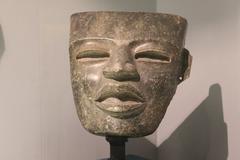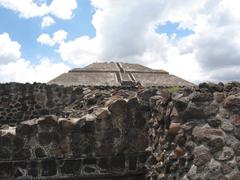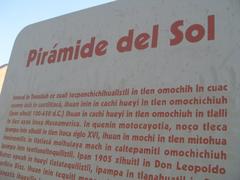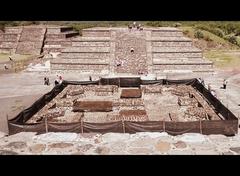
Complete Guide to Visiting the Temple of the Feathered Serpent: Hours, Tickets, and Teotihuacan Historical Sites
Date: 04/07/2025
Introduction
Teotihuacan, located approximately 50 kilometers northeast of Mexico City, is among the most significant and enigmatic archaeological sites in the Americas. Known as “the place where the gods were created,” it flourished from around 100 BCE to 700 CE and became a major political, economic, and religious center, with a population that may have reached up to 200,000 (History.com; Destinationless Travel). Among its monumental structures, the Temple of the Feathered Serpent—alternatively called the Temple of Quetzalcoatl—stands out as a symbol of Teotihuacan’s spiritual life and architectural innovation. This pyramid is renowned for its talud-tablero style and stone carvings of feathered serpents and rain gods, representing fertility, creation, and celestial power (Metropolitan Museum of Art; MexicoHistorico.com).
Archaeological excavations have revealed mass sacrificial burials and thousands of ritual artifacts beneath the temple, highlighting its role as a ceremonial and political hub. A hidden tunnel, discovered in 2003, contained rare offerings such as jade statues, liquid mercury, and ceremonial objects, suggesting profound symbolic and ritual significance (The Archaeologist; Ancient Origins).
This comprehensive guide provides detailed insights into the Temple of the Feathered Serpent—its historical background, cultural importance, architectural features, notable archaeological findings, and practical information for visiting, including hours, ticketing, accessibility, and travel tips. Whether your interest lies in ancient Mesoamerican spirituality, architecture, or cultural heritage, this article will help you plan and enrich your visit (INAH Official Site; Road Affair).
Table of Contents
- Historical Background of Teotihuacan
- The Temple of the Feathered Serpent: Construction and Symbolism
- Archaeological Discoveries and Ongoing Research
- Visitor Information: Planning Your Visit
- Frequently Asked Questions (FAQ)
- Conclusion
- References
Historical Background of Teotihuacan
Origins and Development
Teotihuacan’s origins date to around 400 BCE, with major construction occurring between the 1st and 7th centuries CE (History.com). At its peak, the city covered about 20 square kilometers and supported an estimated 125,000–200,000 inhabitants (Destinationless Travel; The Tourist Checklist). The exact identity of its founders remains debated, though the Aztecs rediscovered and named it centuries later.
Urban Layout and Architectural Achievements
Teotihuacan features advanced urban planning with a grid layout centered on the Avenue of the Dead, a 1.5-mile avenue aligned with the Cerro Gordo volcano (History.com). Major monuments—including the Pyramid of the Moon, Pyramid of the Sun, Ciudadela, and Temple of the Feathered Serpent—are connected by this avenue. The Temple of the Feathered Serpent is the city’s third-largest pyramid, renowned for its intricate carvings of the feathered serpent deity Quetzalcoatl and the rain god Tlaloc (Road Affair; The Tourist Checklist).
Religious and Cultural Significance
Teotihuacan was a polytheistic society with a complex pantheon, including the Great Goddess, Quetzalcoatl, Tlaloc, and Xipe Totec (History.com). The Temple of the Feathered Serpent was a center for religious ceremonies, including ritual sacrifices, as evidenced by mass graves and sacrificial victims found beneath the temple (History.com).
Economic Power and Regional Influence
The city prospered through control of obsidian resources and trade in ceramics, luxury goods, cotton, cacao, feathers, and shells. Its influence extended as far as the Maya region, with its architectural and artistic styles emulated in distant cities (History.com).
Decline and Abandonment
By around 600 CE, Teotihuacan began to decline, marked by fires and destruction of major buildings. The causes remain debated, but by 750 CE, the city was largely abandoned. Its legacy, however, continued to inspire later cultures, notably the Aztecs (History.com).
Temple of the Feathered Serpent: Construction and Symbolism
Built in the early 3rd century CE, the Temple of the Feathered Serpent (also known as the Temple of Quetzalcoatl) is a step-pyramid with six levels, noted for its compact, highly decorated structure (Metropolitan Museum of Art; Wikipedia). Its façade features alternating heads of the feathered serpent (Quetzalcoatl) and the War Serpent, set among motifs of shells, conch, and flowers—symbols of water, fertility, and the underworld (Metropolitan Museum of Art; World Mythos).
Constructed in the talud-tablero architectural style, the temple’s core consists of earth and rubble, faced with cut stone (Alsyed Construction). It is located within the Ciudadela, a massive quadrangular plaza that could accommodate the city’s adult population, emphasizing its ceremonial and administrative significance (Metropolitan Museum of Art).
Archaeological investigations have uncovered more than 200 sacrificial burials beneath the temple, most believed to be warriors or captives, as well as thousands of offerings such as obsidian blades, jade, and shells (Wikipedia; Metropolitan Museum of Art). The temple’s alignment and iconography underscore its religious, cosmological, and political significance.
Archaeological Discoveries and Ongoing Research
Discovery and Structure of the Tunnel
In 2003, a sinkhole caused by heavy rain revealed the entrance to a previously unknown tunnel beneath the temple (The Archaeologist). Led by archaeologist Sergio Gómez, researchers uncovered a 100-meter-long tunnel running from the Ciudadela plaza to the temple’s center, sealed with large boulders nearly 2,000 years ago.
The tunnel, dating to around 100–200 CE, descends 18 meters underground and leads to three sub-chambers beneath the temple. Its sophisticated construction and deliberate sealing highlight its ritual and political importance (Ancient Origins).
Major Archaeological Finds
- Ritual Offerings: Thousands of artifacts, including jade statues, shells, rubber balls, pyrite mirrors, obsidian blades, ceramics, and remains of jaguars and other animals, were found in carefully arranged caches (The Archaeologist).
- Liquid Mercury: Large quantities of liquid mercury were discovered—likely representing an underworld river or lake, a material associated with royalty and the supernatural (Ancient Origins).
- Human Remains: More than 200 burials—many believed to be sacrificial victims—were uncovered, further highlighting the temple’s role in state and religious ritual (Metropolitan Museum of Art).
Interpretations and Theories
Scholars interpret the temple and tunnel as symbolic representations of Teotihuacan’s creation myths, with the city’s urban layout aligned to celestial events and the watery symbolism representing emergence from primordial darkness (The Archaeologist). The sub-chambers may have served as elite tombs, though further research is ongoing (Ancient Origins).
Ongoing Research and Technological Innovations
Robotic technology is used to explore the tunnel safely, and multidisciplinary teams continue to study and preserve the finds (Ancient Origins; The Archaeologist).
Visitor Information: Planning Your Visit
Visiting Hours and Ticket Information
- Hours: Open daily from 9:00 AM to 5:00 PM (closed Mondays for the museum).
- Tickets: General admission is approximately 80–85 MXN (about $4–5 USD). Reduced rates are available for students, seniors, and Mexican residents. Tickets can be purchased at the entrance or via the INAH Official Site.
Getting There
- By Public Transport: Buses depart from Mexico City’s Terminal de Autobuses del Norte every 15–20 minutes; the trip takes about one hour.
- Guided Tours: Many operators offer guided tours, some including transportation and visits to the Pyramids of the Sun and Moon.
Accessibility and Tips
- The site is extensive with uneven terrain. Comfortable shoes, sunscreen, water, and a hat are recommended.
- Some areas are wheelchair accessible, but the Temple of the Feathered Serpent is not suitable for visitors with limited mobility.
- Climbing the Temple of the Feathered Serpent is prohibited to preserve its delicate carvings; climbing is allowed only on the Pyramid of the Sun and Pyramid of the Moon.
Guided Tours, Special Events, and Nearby Attractions
- Guided Tours: Available at the entrance or through private operators, offering valuable historical and cultural context.
- Special Events: Spring equinox ceremonies and cultural festivals are held periodically (Goats on the Road).
- Nearby Attractions: Don’t miss the Pyramid of the Sun, Pyramid of the Moon, and the Teotihuacan Museum, which displays artifacts from recent excavations.
Photography
- The Ciudadela plaza and the Avenue of the Dead provide excellent photo opportunities. Early morning and late afternoon offer the best light.
- Drone photography and professional equipment may require special permits.
Frequently Asked Questions (FAQ)
Can I climb the Temple of the Feathered Serpent?
No, climbing is not allowed to protect the temple’s carvings.
Are guided tours available?
Yes, guided tours are highly recommended and available in multiple languages.
Is the tunnel beneath the temple open to visitors?
No, but artifacts discovered in the tunnel are displayed in the on-site museum.
How do I buy tickets?
Tickets can be purchased at the entrance or online via official channels.
Is the site accessible to people with disabilities?
Some areas are accessible, though the terrain and steps may limit access to the temple itself.
Conclusion
The Temple of the Feathered Serpent is a testament to the ingenuity, spirituality, and artistry of ancient Teotihuacan. Its talud-tablero design, elaborate serpent iconography, and ongoing archaeological discoveries provide remarkable insight into Mesoamerican civilization (Metropolitan Museum of Art; MexicoHistorico.com). With practical visiting hours, affordable tickets, accessible travel, and enriching guided tours, experiencing this site is both convenient and memorable. Enhance your visit by planning ahead, exploring the museum, and joining expert-led tours. For the latest updates, special events, and travel tips, consult official sources and cultural platforms (INAH Official Site; Audiala App).
Embark on your journey to Teotihuacan and discover why the Temple of the Feathered Serpent continues to inspire awe and scholarly fascination.
References and Further Reading
- History.com
- Destinationless Travel
- The Tourist Checklist
- Thespunkycurl
- Road Affair
- Smithsonian Magazine
- INAH Official Site
- MexicoHistorico.com
- Metropolitan Museum of Art
- Wikipedia
- Alsyed Construction
- World Mythos
- Archaeology Travel
- The Archaeologist
- Ancient Origins
- Goats on the Road




